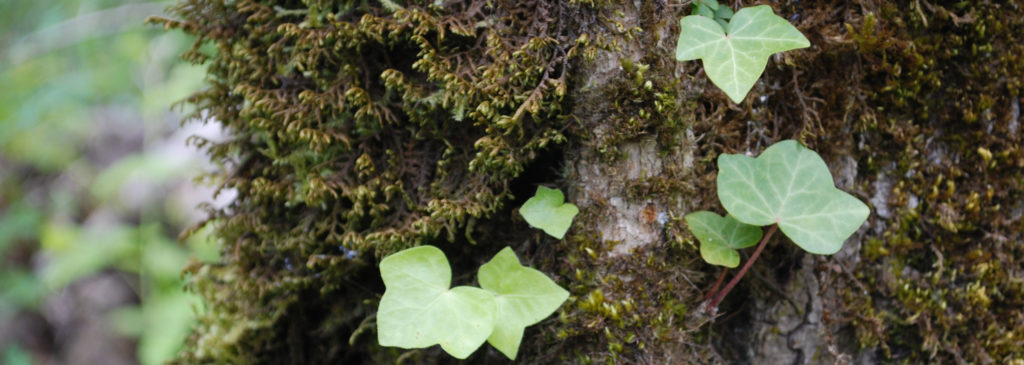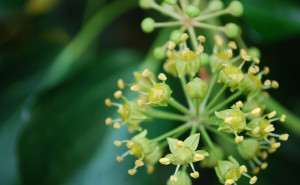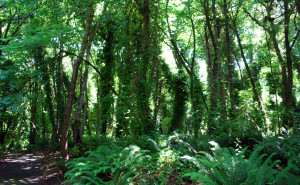English ivy (Hedera helix) may conjure up images of cozy, country cottages, but don’t be deceived. This invasive weed can destroy buildings, poison pets, and topple trees.
The very characteristics that made it a popular ornamental plant – grows quickly, requires little maintenance, and provides a “no-mow,” evergreen ground cover — are the things that have led to it being designated as a Class B noxious weed in Oregon. This means that it is a regulated weed of economic importance which is regionally abundant but may have limited distribution in some Oregon counties. It also means that the propagation, transport, and sale of this plant is prohibited by law.
Ivy is abundant in Clackamas County. You’ve probably seen it carpeting the ground in a natural area, possibly covering a wall, or climbing high up in a tree. Native to Europe and Asia, extending down into Northern Africa, English ivy was introduced to the United States in the 1700s as an ornamental plant. Like many landscaping plants, however, it quickly naturalized and spread aggressively into our residential and natural areas.
How Do I Know if it’s English Ivy?
There are actually three, similar-looking ivy (Hedera) species in Oregon that are referred to collectively as “English” ivy. These include English ivy (Hedera helix), Atlantic ivy (H. hibernica), and Persian ivy (H. colchica). Distinguishing between the ivies can be difficult and often requires a microscope to tell them apart. Ivy identification is a hotly debated topic among the District WeedWise staff! A good rule for landowners is, “If it’s ivy, it’s a problem to be managed.”
If, by chance, you do happen to have a microscope with at least 40x magnification, look for tiny hairs on the underside of juvenile leaves to identify Atlantic ivy, considered the most common ivy in Oregon. Be aware, however, that weather exposure can rub off these hairs, rendering this feature somewhat confusing at best.
English and Atlantic ivies are also known as “Baltic,” “Irish,” “European,” and “common” ivy. Both of these types of ivy are listed as noxious weeds here in Oregon.
How Can I Identify Ivy?
Ivy is an evergreen, perennial climbing vine. Vines can grow up to 100 feet long and older stems can grow up to one foot in diameter. It is a hardy plant, with specimens living for up to 400 years.
Roots form along the stem, allowing it to attach to either the ground or vertical surfaces. A hardy opportunist, ivy can continue to grow through the winter months, when other plants are dormant.
Ivy has both a juvenile and mature stage. To reach maturity, the juvenile plant must grow vertically on something like a tree, fence, wall, building, or even a small hill. Flowers and berries will only appear on mature ivy. The flowers are small, greenish-white, and grow in umbrella-shaped clusters. Berries are purplish-black and many birds, especially starlings and robins, will eat them and disperse the seeds widely from the parent plants.
Juvenile ivy leaves alternate on the stem and are leathery, with 3-5 lobes. Mature leaves tend to be unlobed and diamond-shaped. So many cultivated varieties of ivy exist, however, that leaves are an unreliable feature for identification.
Why Should I Care About English Ivy?
Ivy grows in thick mats, blocking sunlight, and crowding out other plants, including native plants, in our natural areas. The loss of native plants decreases the availability of food and cover for our native wildlife. This thick carpet of ivy also inhibits the ability for new trees, shrubs, and ground cover plants from getting established, creating what some call an “ivy desert.”
Climbing ivy can be very damaging to trees and forests. Ivy vines can trap moisture against the trunk of a tree, inviting rot and pests. Left to grow, the ivy can spread into the tree canopy. The additional weight can cause these trees to topple, especially in high-wind storms and when the ground is wet or saturated.
Trees are not the only casualties of ivy. Ivy can damage buildings, fences, and other structures when invading roots widen existing cracks, allowing moisture to penetrate.
Additionally, these invasive plants contain chemicals that can cause severe dermatitis in sensitive humans. There have also been reports of poisoning in cattle, dogs, and sheep when they have consumed English ivy leaves.
How Can I Control Ivy?
Ivy can be pulled from the ground and off trees when still young and pliable. Older, thicker stems require cutting tools. Be sure to wear gloves and long sleeves as ivy can be a skin irritant (although not in the same way as the infamous poison ivy or poison oak). When pulling ivy from the ground, all runners must be removed because the remaining root sections can sprout and grow.
At the minimum, remove ivy from trees both to prevent the trees from falling and to prevent the ivy from maturing and producing seed. Be sure to clear the ivy around the tree base as it will quickly grow right back up the trunk.
Ivy can be left on-site to decompose, as long as roots are placed in such a way as to prevent them from touching the soil and growing. Sites should be monitored for sprouting vines. Be aware that extensive pulling operations can disturb the soil, providing a place for other plants to move in, both native and invasive. Follow-up is highly encouraged!
Learn More
For more information about English ivy check on these resources
-
Best Management Practices: English Ivy
-
WeedWise Plant Profile: English Ivy
-
Oregon Dept of Agriculture English ivy – Hedera helix
-
USDA Plants Profile for Hedera helix (English ivy)
-
English ivy Weed Bulletin- King County
-
English ivy– Washington State Noxious Weed Control Board
-
Invasive.org: English ivy
-
Invasive Species Compendium: English ivy





